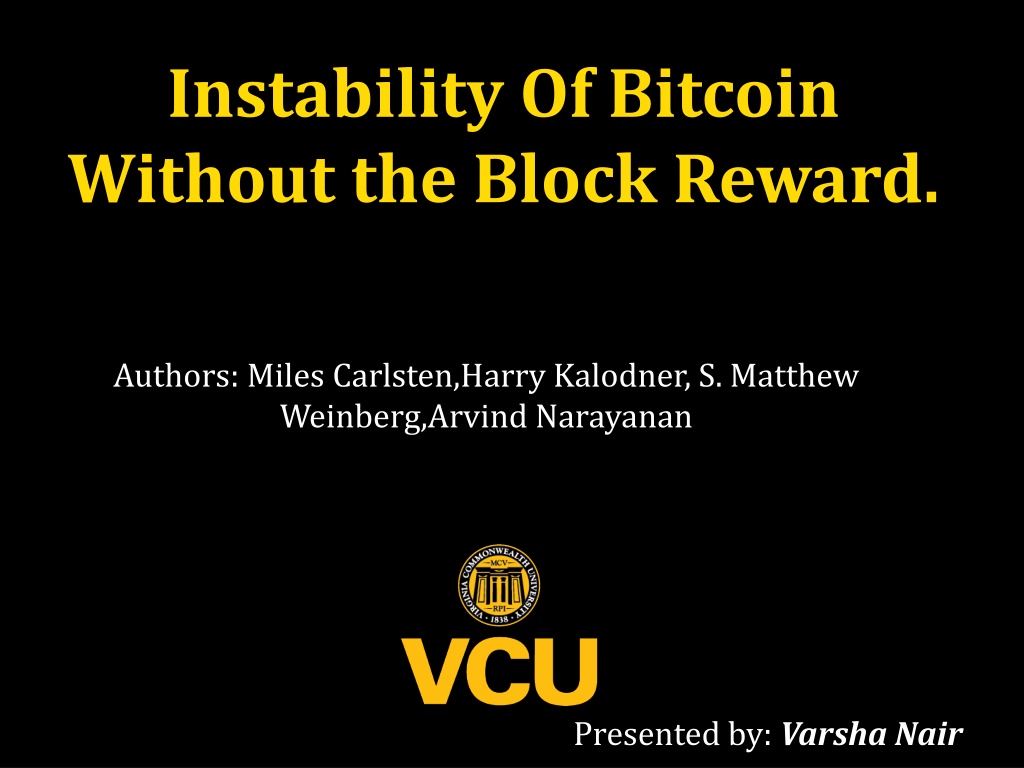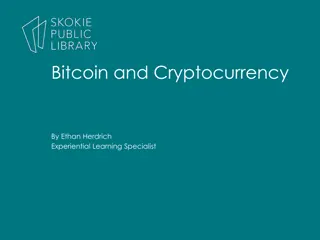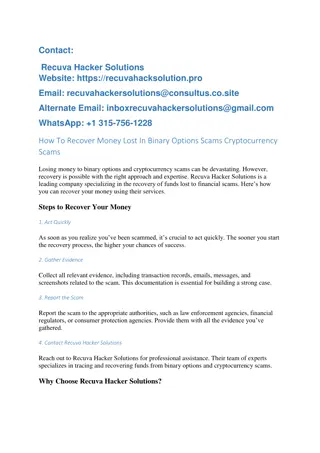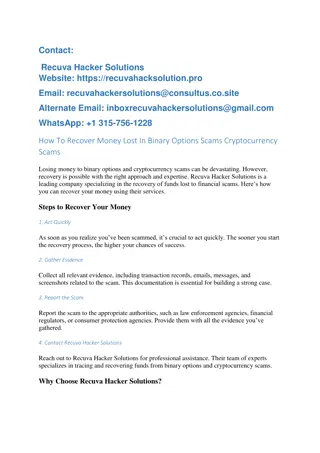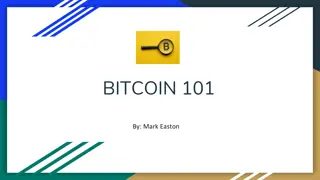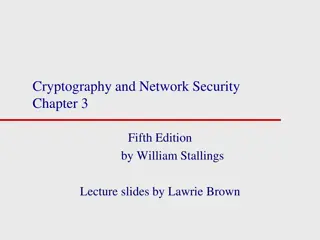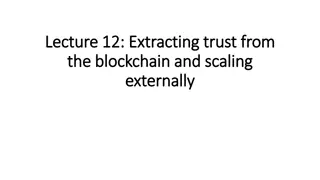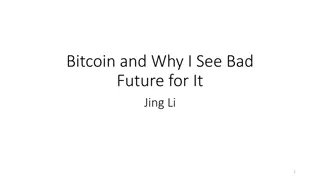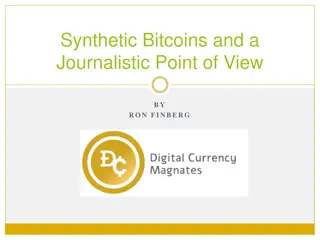Instability of Bitcoin Without Block Reward
This study delves into the potential instability of Bitcoin when block rewards disappear, exploring how transaction fees may impact security and the implications for mining strategies. Discover the threats posed by forking and the challenges faced in maintaining the network's overall hash rate.
Download Presentation

Please find below an Image/Link to download the presentation.
The content on the website is provided AS IS for your information and personal use only. It may not be sold, licensed, or shared on other websites without obtaining consent from the author.If you encounter any issues during the download, it is possible that the publisher has removed the file from their server.
You are allowed to download the files provided on this website for personal or commercial use, subject to the condition that they are used lawfully. All files are the property of their respective owners.
The content on the website is provided AS IS for your information and personal use only. It may not be sold, licensed, or shared on other websites without obtaining consent from the author.
E N D
Presentation Transcript
Instability Of Bitcoin Without the Block Reward. Authors: Miles Carlsten,Harry Kalodner, S. Matthew Weinberg,Arvind Narayanan Presented by: Varsha Nair
AGENDA DUAL REWARDS IN BITCOIN. SECURITY THREAT IN BITCOIN. DEVIANT MINING STARETGIES MINING EQUILIBRIUM. FUTURE RESEARCH. LIMITATIONS. 2
MOTIVATION Blocks rewards are main source of mining income. Block rewards eventually get replaced by transaction fee paid to miners. Common belief is block rewards or transaction fees have no impact on security. Researchers were inspired to look at long term stability of bitcoin when block rewards disappear completely. 3
Bitcoin Security Threat. Bitcoin game s theoretic stability breaks down when block reward disappears. WHY??. Exponentially distributed block arrival time leads to blocks with uneven transaction fees. It becomes attractive to fork a wealthy block to steal the rewards therein. 8
Bitcoin Security Threat. Bitcoin game s theoretic stability breaks down when block reward disappears. HOW?? Rational miners are incentivized to deviate from the standard behavior. Higher orphan block rates lead to lower security. Purposeful forking increases transaction throughput. Bitcoin's security and overall hash rate goes down. 9
Bitcoin Mining Gap. Without a block reward, after a block is found where all the available transactions were made part of the block, there is zero expected reward, but non-zero electricity cost, making it unprofitable for the miner to mine. So when gaps exists between mining blocks, miners would not mine until the point they can justify that there are enough transactions that would pay them the transaction fee which would cover the cost of electricity and earn profits. The mining gaps result in lowering the overall hash power of the network. This makes it easier for a malicious miner to fork. During mining gaps turning the rigs on and off is quite infeasible too , thereby encouraging miners to deviate from the default protocol. 10
RESEARCH CONTRIBUTIONS. Mining strategy simulator: a. Miners in simulation learn over time which strategies are successful using no-regret learning algorithms. Strategies are developed around three questions: Which block to extend. How much of the outstanding transactions to include in the block. When to publish found blocks. Simulator allowed modeling different numbers of miners, hash power distributions, network latencies, and reward schemes. b. c. Research on Deviant Mining Strategies. 12
Deviant mining strategy-1. One block Fork Rational miners will mine on top of the block with the largest transaction pool. In this case B. This happens in the 1 block fork. 13
Deviant mining strategy-2. Undercutting 1 block fork transitions to undercutting strategy. Miners will fork the head of the chain. A non-equilibrium happens with increasingly aggressive undercutting. Transactions are left unclaimed to incentivize selfish miners. Equilibrium is attained where miners include only a fraction of available transactions into their blocks 14
Deviant mining strategy-3 Selfish Mining Revisited Selfish mining performs slightly better in the transaction fee model. Selfish miners can make the decision whether to hide their block based on the value of the transactions in the block. This improved selfish mining strictly and always outperforms both default mining and traditional selfish mining. 15
Deviant mining behavior phases PHASE ONE: Petty compliant Miners incentivize by mining on the block that leaves the most transactions fees unclaimed. PHASE TWO: Lazy Undercutting. Once some fraction of miners is petty compliant, other miners make profit by intentionally forking the chain. Forks the blockchain if the head block is more valuable than the unclaimed transaction fees it leaves behind. Only takes half of the possible transaction fees to prevent other lazy forkers from forking their block. 16
Deviant mining behavior phases PHASE THREE: AggressiveUndercutting. Aggressively optimize the tradeoff between -Maximizing the transaction fees included in blocks they mine -Minimizing the chance that their block will be undercut by other miners in the system. 17
Undercutting Equilibrium. An equilibrium exists where all miners use the same undercutting strategy. It induces a growing backlog of transactions. Even if 66% of miners remain honest, undercutting is profitable. 19
Research Results In the transaction fee model, selfish miners outperforms traditional selfish mining. In a block chain with constant forks caused by undercutting, an attacker's effective hash power is magnified because he will always mine to extend his own blocks. 51% attack possible with much less than 51% hash power. Lot of orphaned blocks brings down the overall security of block chain. Block reward is integral to the stability of mining game. Analyzing equilibrium in the transaction-fee regime appears dramatically harder than in the block-reward regime 20
Future Research: Space in the block chain will be a scarce resource in the future. Market will emerge, with users being able to speed up the confirmation of a transaction by paying a sufficiently large transaction fee. But what if miners intentionally leave money on the table when solving blocks, as is the case in undercutting. Block size imposes a constraint on the total size of transactions in a block . Threat of being undercut imposes another constraint on the total fee. This thought leads to another area of research. 21
Limitations The researchers have not presented an analysis of miners whose strategy space includes both undercutting and selfish mining. The researchers have not proposed a resolution to preventing the under-cutting problem from happening. Mining simulator cannot model mining pools . Simulation of a non-constant arrival rate of transactions not possible. 22
THANK YOU!!!! Questions?? 23
